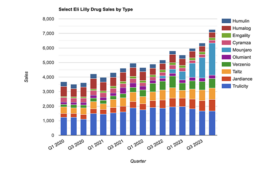
The European Society for Medical Oncology (ESMO) is wrapping up. About 24,000 people from 131 countries attended the congress this year. With a record number of abstracts, 1,736 were selected to be presented. Here are just a few of the highlights.
Melanoma
The trial: COMBI-AD
The findings: Combined dabrafenib plus trametinib as an adjuvant treatment for patients with high-risk BRAF V600-mutated melanoma after surgical resection significantly decreased the risk of death or recurrent disease.
The study details: The Phase III COMBI-AD trial stratified 870 patients according to BRAF mutation (V600E versus V600K) and stage (IIIA versus IIIB versus IIIC); 18 percent of patients were stage IIIA, 41 percent IIIB, 40 percent were IIIC, and 1 percent of patients had unknown stage disease.
Researchers randomized 438 patients to receive dabrafenib at 150 mg twice daily plus trametinib at 2 mg once daily, and 432 patients to receive matching placebo for 12 months. The primary endpoint was relapse-free survival (RFS), with secondary endpoints of overall survival (OS), distant metastasis-free survival (DMFS), freedom from relapse (FFR), and safety.
After 2.8 years, the risk of disease recurrence or death was reduced by adjuvant dabrafenib plus trametinib by 53 percent compared to placebo.
In COMBI-AD, adjuvant therapy with dabrafenib and trametinib was associated with improvements in RFS, OS, DMFS, and FFR, and demonstrated manageable safety in patients with high-risk, resected, stage III, BRAF V600E/K–mutated melanoma.
The trial: CheckMate 238
The findings: Patients with stage IIIb/IIIc or stage IV melanoma at high risk of recurrence following complete surgical resection had greater recurrence-free survival (RFS) with adjuvant nivolumab compared to adjuvant ipilimumab.
Nivolumab and ipilimumab are immune checkpoint inhibitors that restore immune anti-tumor activity by different mechanisms.
Nivolumab blocks the programmed death 1 (PD-1) receptor and ipilimumab targets the cytotoxic T lymphocyte-associated antigen 4 (CTLA-4) molecule on T cells.
Both drugs are currently approved for treatment for advanced melanoma.
The study details: The ongoing Phase III, double-blind study randomized 906 patients to receive either nivolumab at 3 mg/kg i.v. every two weeks or ipilimumab at 10 mg/kg i.v. every 3 weeks for four doses and every 12 weeks thereafter until documented disease progression or unacceptable toxicity, up to a maximum treatment duration of one year.
The primary endpoint in the study was relapse-free survival (RFS), defined as the time between randomization and the date of first recurrence or death.
Overall, stage IIIb, IIIc, and IV disease was reported for 34 percent, 47 percent, and 19 percent of patients, respectively. Thirty-two percent of patients had ulcerated primary disease, 48 percent had macroscopic lymph node involvement, and 42 percent of patients were positive for the BRAF mutation.
RFS was significantly improved with nivolumab over ipilimumab at a median follow-up of 18.5 months; the 18-month RFS rates were 66.4 percent versus 52.7 percent, respectively.
Breast Cancer
The trial: LORELEI
The findings: Adding taselisib to letrozole before surgery significantly improved outcomes for patients with early breast cancer that was both estrogen receptor positive and HER2-negative (ER+/HER2-).
Taselisib is an alpha specific PI3K inhibitor that blocks a signaling pathway known as PIK3 that promotes cancer growth.
The study details: LORELEI included 334 postmenopausal patients with ER+/HER2-, stage I-III, operable early breast cancer.
All of them had tissue analyzed for PIK3CA mutant cancer cells, and were randomized to receive letrozole plus either a placebo or taselisib for 16 weeks in order to shrink their tumor before surgery.
The study had two co-primary endpoints: one was objective response rate (ORR), which was assessed by measuring the tumor size with magnetic resonance imaging; the second was the pathologic complete response (pCR) rate, which is a measure of the presence of cancer cells at the site after the tumor is surgically removed.
The study showed that ORR was better in patients who received taselisib compared to placebo (50 percent versus 39.3 percent), but there was no significant difference between the groups for pCR.
The trial: MONARCH 3
The findings: The addition of abemaciclib, a cyclin-dependent kinase (CDK) 4/6 to non-steroidal aromatase inhibitors (NSAIs) anastrozole or letrozole reduced the risk of progression or death by 46 percent compared with the NSAI alone for previously untreated patients with HER2-negative, HR-positive advanced breast cancer.
The study details: The Phase III MONARCH 3 trial randomized 493 postmenopausal women with locoregionally recurrent or metastatic breast cancer to receive either continuous abemaciclib at 150 mg twice daily or placebo. All patients also received either 1 mg of anastrozole or 2.5 mg of letrozole once daily.
Results at 18 months found the ORR was 59 percent in the abemaciclib arm versus 44 percent with placebo. The complete response rate with the CDK4/6 inhibitor was 1.5 percent versus 0 percent with a non-steroidal aromatase inhibitor alone. There was not enough data to determine OS.
Gastric Cancer
The Trial: KEYNOTE-059
The findings: Pembrolizumab showed a promising response rate in for both newly diagnosed and previously treated patients with metastatic gastric cancer. Investigators found an overall objective response rate of 12 percent with pembrolizumab alone in the previously treated patients, for those who expressed programmed death-ligand 1 (PD-L1).
In patients with newly diagnosed metastatic cancer, both the combination therapy (pembrolizumab and chemotherapy) and pembrolizumab alone were safe and showed some promising activity.
The study: The Phase II study included three cohorts: 1) 259 patients with metastatic gastric cancer who received the programmed death 1 (PD-1) inhibitor pembrolizumab alone, after pretreatment with two or more lines of chemotherapy; 2) 25 patients with newly diagnosed metastatic gastric cancer who received a combination of pembrolizumab and chemotherapy; and 3) 31 patients with newly diagnosed metastatic gastric cancer who received pembrolizumab alone.
The primary endpoints were safety (all three cohorts) and objective response rate (cohorts one and three).
After six months, results showed a response rate in patients with metastatic gastric cancer. Investigators found an overall objective response rate of 12 percent with pembrolizumab alone in the pretreated patients, with patients who expressed PD-L1 more likely to respond than those who did not, with objective response rates of 16 percent and 6 percent, respectively.
In patients with newly diagnosed metastatic cancer, both the combination therapy (cohort two) and pembrolizumab alone (cohort three) were safe and showed some promising activity.
Ovarian Cancer
The trial: ARIEL 3
The findings: Rucaparib maintenance therapy increases progression-free survival (PFS) in BRCA mutant recurrent ovarian cancer by 77 percent.
The study details: ARIEL3 randomized 564 patients with high grade ovarian cancer who had responded to platinum-based chemotherapy in the second or third line of treatment to receive rucaparib maintenance therapy or placebo.
The primary endpoint was PFS, which was measured sequentially in three groups if benefit was found in the previous group: 1) BRCA mutant; 2) BRCA mutant or BRCA wild type with high LOH (together called homologous recombination deficient or HRD); 3) intention to treat (entire study population).
Rucaparib led to a statistically significant improvement in PFS in all three groups. PFS increased from 5.4 months to 16.6, 13.6, and 10.8 months in groups 1, 2, and 3, respectively.
Filed Under: Drug Discovery




